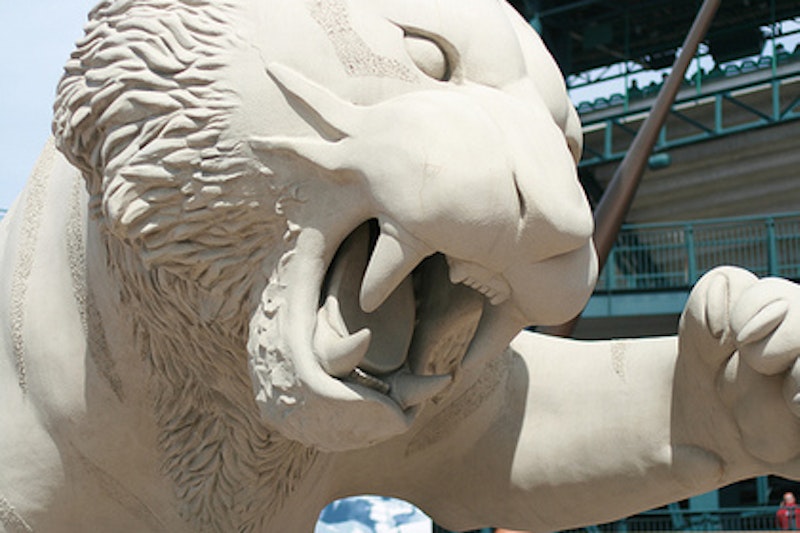I have the mixed blessing of a deep-rooted relationship with Oriole Park at Camden Yards. My family had season tickets for many years and it was in October of 1996—the home playoff game against the Yankees immediately following the second-only-to-Maradona “hand of God” incident—that I first tasted the sweet bile of Yankee-spawned hatred. And nothing on Earth will top Cal Ripken, Jr.’s 2,131st consecutive game.
The environment of the park itself is indelible to the shelf life of these memories. Camden Yards is well to the right of the bell curve of what we expect from stadiums nowadays. It is a singular fusion of the essentials: baseball, geography, history and tone. These tropes are crystallized in one particular approach to the park that takes you through acres of parking lots, the entire vista a tribute to the phalanxes of stadium lights and the great brick warehouse running behind right field and Boog’s BBQ. It's a glorious success.
Still, a lot of children fall in love with their hometown ballparks simply because baseball, regardless of the stadium, has that power. But only the best ones resonate like Camden Yards.
There is another end of the spectrum, however. Stadiums, like any massive public structure, risk blemishing skylines and neighborhoods on a massive scale—they take years to build and are rather complicated things to get rid of. Let’s not even get into the atrocious reality of stadium names; they’re the necessary byproduct of huge corporations underwriting construction costs, or paying enormous sums for the privilege of brand identification, in the first place.
The magic of home runs and game-winning touchdowns and buzzer-beaters isn’t entirely subverted by horrendous architecture or corrupt corporations, but at least one instance comes close.
I had the pleasure of witnessing the re-emergence of the Detroit Tigers as a competitive ball team. I got five years of schooling in Ann Arbor, worked in Detroit and made it out to a good number of games at Comerica Park in downtown D-town. After paying someone $5 to “look after” my parked car, walking by Hockey Town and the Bolshevik-esque Fox Theater and feeling a steady pulse from a down-but-certainly-ain't-out town, I’d behold the park for its antithetical splendor.
I’ve experienced over half a dozen ballparks—not an astounding amount, I realize—and Comerica is, without a doubt, the worst example of a baseball stadium I have ever seen.
Any sports stadium has two main motifs from which to draw a visual narrative: the sport itself and the team name. In the case of Comerica, we have baseball and tigers. The resulting visual assault is most similar to a balls-out amusement park. Massive, massive baseball bats and tigers flank the main entrance; along the curving sides there are tiger heads gripping baseballs in their mouth (a la pigs with apples) and wavy claw marks. Altogether the stadium has all the subtlety of a foul ball to the forehead. It is kitsch—offensively ugly kitsch.
Though the one-block radius around the stadium is bustling, the surrounding neighborhoods and skyline are marked with looming abandoned buildings and empty lots. The city as well as the state of Michigan is going through tough times as the automobile industry founders and flails. Now, a baseball stadium (or any other type of stadium) need not be a literal reflection of its home city and state—indeed, such an approach would be ripe for catastrophic failures. But the wantonness of Comerica Park's commercialism is decidedly jarring. My first visit there recalled trips to Funland on the boardwalk at Rehobeth Beach, Delaware. There are video games as well as ridiculous neon "cocktails" in long plastic "cups" (unfortunately many stadiums suffer from this last blight). Where was the ferris wheel? Or the gravitron?
That Detroit is suffering commercially, and the stadium is over the top commercial, is the point. The intentions, I'm sure, are benevolent but the result borders on mocking.
The stadium is built to appeal to kids. And why not? Get 'em while they're young so they keep coming back. But something is lost in translation. Something is missing from the park, something that, to be fair, you can't create out of nothing no matter how much brick and ivy you might have. But stadiums that so readily drop to the lowest common denominator in visual and architectural appeal sacrifice what imbues the stadium with a consciousness greater than the sum of its parts.
I'm not asking Comerica to look like Camden Yards. The Orioles' stomping grounds was made to look "retro" and it worked. Every park has its own feel: modern, retro, minimal, extravagant. But a little tact can go a long way. Somewhere along the way, the planners of Comerica figured that gaudiness is king; that glitz and cartoonish architecture will prevail. The sad reality is that the park looks like a scene from a bad children's movie. To risk a little cliché, the stadium could look a little tougher, a little more industrial—not Rouge Plant industrial, but sometime a little more congruent with the city around it. What about a little technological sexiness? Anything but the kitsch.
I certainly don't expect Detroit to scrap Comerica and build another park. I do hope, though, that future stadiums take greater consideration of their surroundings than the situation in the middle of D-town.
Baseball's Difficult Architectures
Money’s obviously the bottom line, but can’t stadium designers at least try to reflect a city’s personality in their buildings?

Photo by mrkumm
